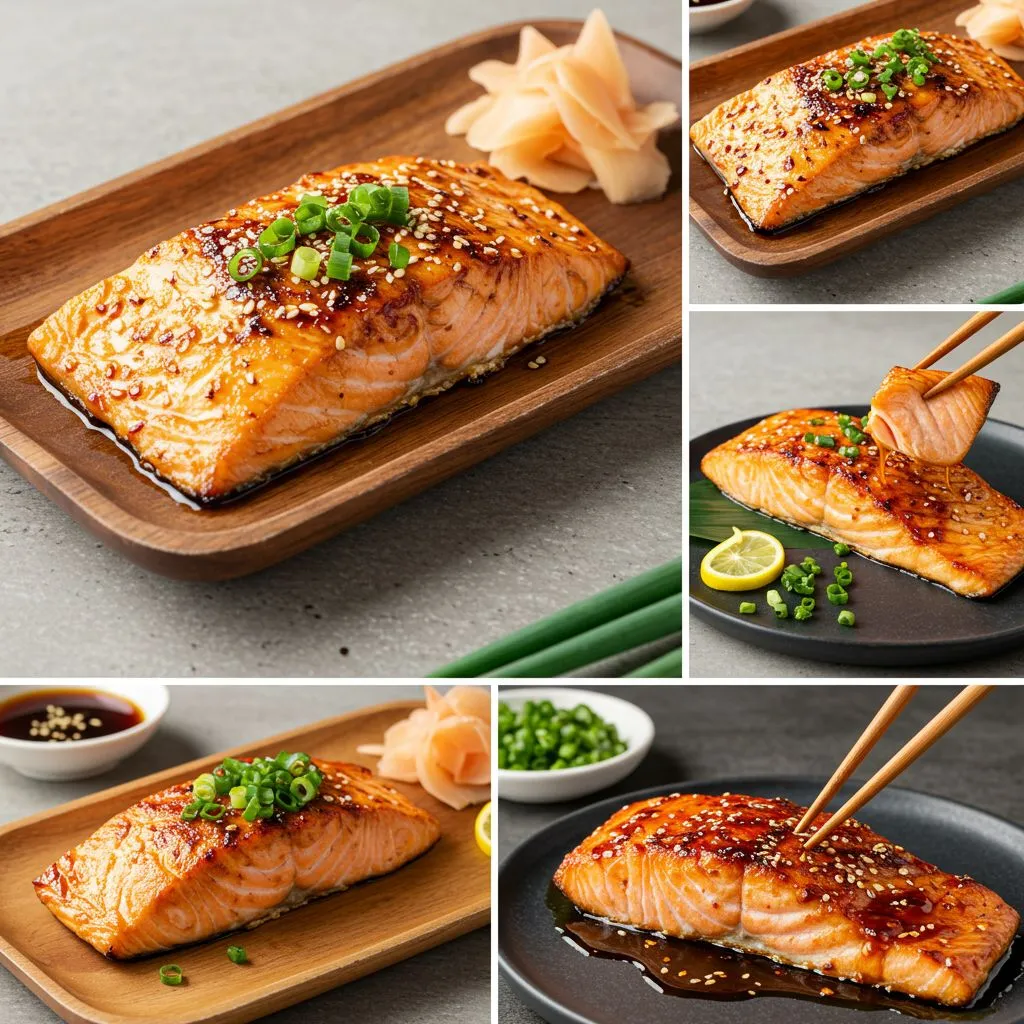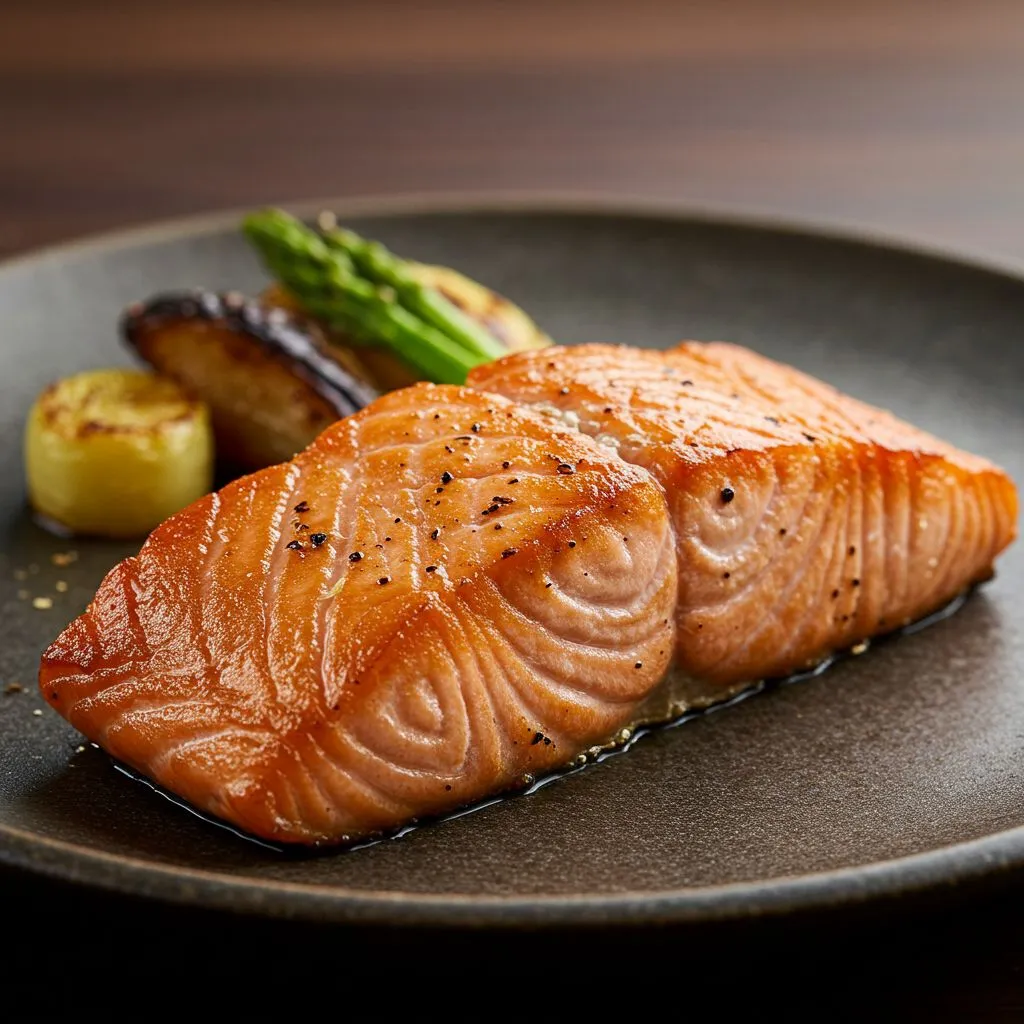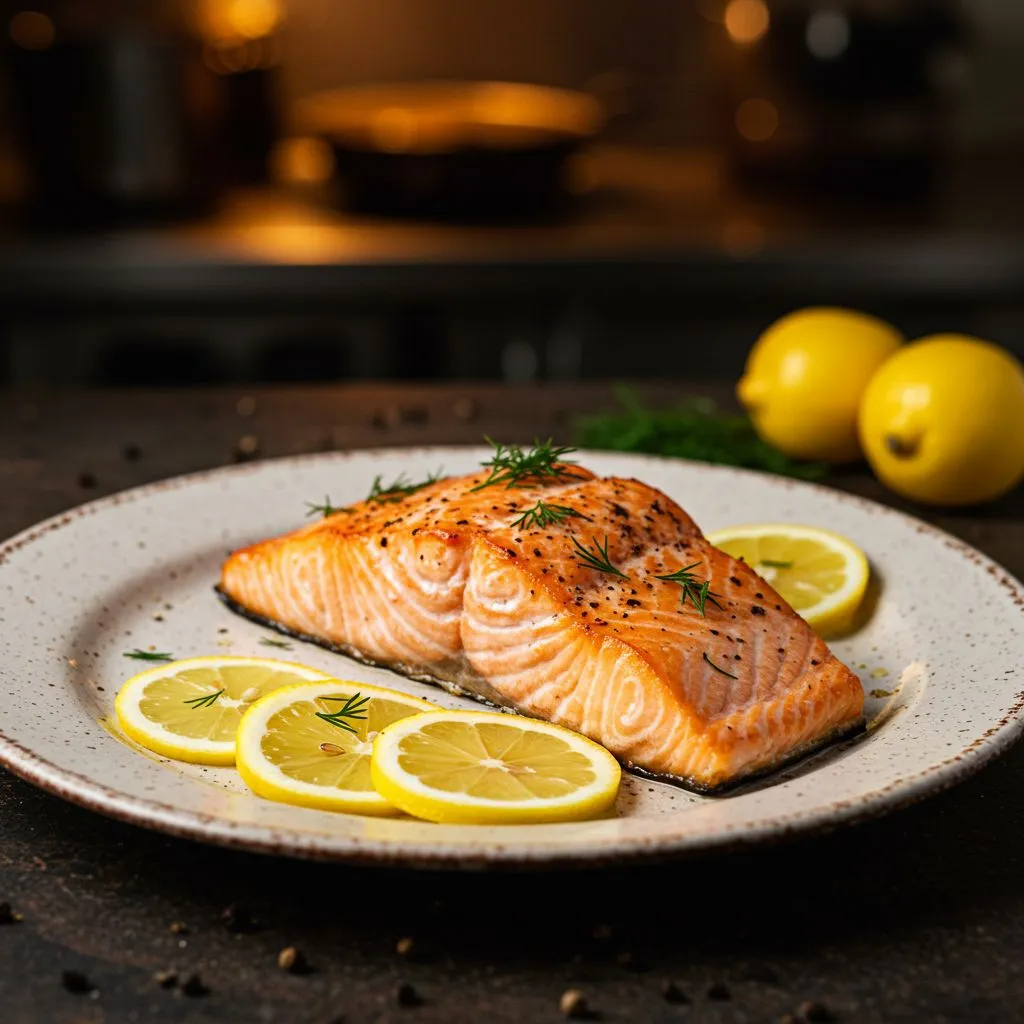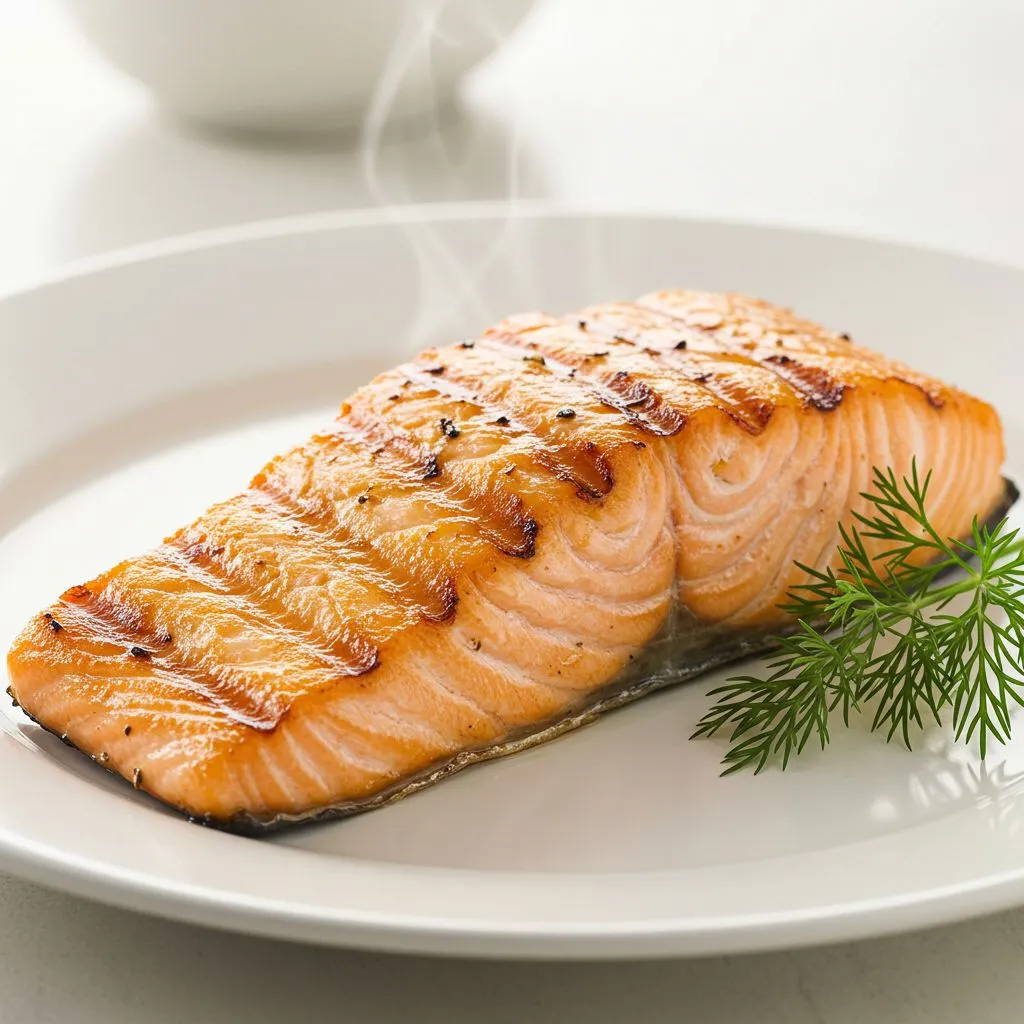Salmon Collar, also known as Kama, is a hidden gem in the world of seafood, particularly beloved in Japanese cuisine. This flavorful cut comes from the neck area of the salmon and is often overlooked in favor of more common parts like the fillet. However, its unique texture and rich taste make it a special addition to your dinner table. This article will walk you through all the essentials of cooking salmon collar, from selection to preparation, and even pairing it with delicious side dishes.
What is Salmon Collar (Kama) and Why is it Special?
Understanding the Salmon Collar Cut
The salmon collar, or kama, is a cut that comes from the neck region of the fish, where the fish, which features a combination of tenderness and fattiness. This part of the fish is often considered a delicacy in Japanese restaurants, where it is grilled to perfection. The makeup of the salmon collar—with its meat, skin, and bones—creates an experience that is both flavorful and texturally satisfying. This unique cut has become increasingly popular among seafood enthusiasts for its succulent quality, making it a must-try for anyone looking to explore different parts of the fish.
When you cook salmon collar, the fatty nature of the meat lends itself well to various cooking methods. Grilling is particularly popular, as it enhances the natural flavors while allowing the fat to render down, resulting in a juicy, smoky piece of fish. To fully appreciate its culinary value, it’s important to understand the salmon collar cut—it’s more than just a portion of the fish; it’s a chance to experience a richer, more savory flavor profile that is often found in the belly region as well.

Why is Salmon Kama Considered the Best Part of the Fish?
Salmon kama is often touted as the best part of the fish due to its rich, succulent flavor and tender texture. Unlike the more commonly used fillet, the collar contains a higher fat content, which translates to an incredibly moist and tender dish when cooked properly. The unique blend of meat and skin adds depth to each bite, making it a favorite among both chefs and home cooks. In many cultures, particularly in Japan, fatty cuts of fish are celebrated for their taste and mouthfeel, and salmon kama is no exception.
Furthermore, the salmon collar is not only delicious but also versatile. It can be marinated in various sauces, such as miso or soy, enhancing its flavor profile even further. This versatility, combined with the inherent richness of the fish, makes salmon kama a standout choice for those looking to explore new seafood options. As more people discover this culinary delight, its reputation as a premium cut continues to grow, making it a sought-after dish in both restaurants and home kitchens alike.
How to Choose the Best Salmon Collar for Cooking
When selecting the best salmon collar for cooking, freshness is key. Look for pieces that are bright in color and have a clean, ocean-like smell. The meat needs to be firm when pressed, with smooth, shiny, undamaged skin. Avoid any collars that have a dull appearance or an unpleasant odor, as these may indicate that the fish is not fresh. Additionally, consider the source of your salmon; sustainably sourced fish is not only better for the environment but often has superior flavor and quality.
Another factor to consider is the size of the salmon collar. A larger collar typically offers more meat and fat, which can enhance the overall eating experience. However, smaller collars can be just as delicious and may be easier to handle when grilling or frying. Whether you choose a larger or smaller piece, ensure it is well-trimmed and free from any excessive bones, allowing for a seamless cooking experience. By focusing on these aspects, you can ensure that your salmon kama will be a delicious addition to your meal.
How to Cook Salmon Collar Perfectly?
Grilling Salmon Collar: Step-by-Step Guide
To grill salmon collar perfectly, start by patting it dry with a paper towel, which helps remove excess moisture and allows for better grilling. Next, marinate the collar in your choice of sauce, such as a miso marinade, Let it marinate for a minimum of 30 minutes, or leave it overnight to deepen the flavor. Before grilling, preheat to medium-high and make sure the grill is clean and lightly oiled to avoid sticking. When ready, grill the salmon collar with the skin facing down for 4–5 minutes, then flip and cook for an additional 4-5 minutes until the fish is opaque and flakes easily with a fork.
Keep a close eye on the fish as it grills to prevent overcooking, which may result in dryness. The natural fat content in the salmon collar will help keep it moist, but it’s important to track the cooking time carefully. For added flavor, baste the fish with leftover marinade during the grilling process. Once cooked, allow the salmon collar to rest for a few minutes before serving, which will help retain its juices and enhance the overall flavor.
Frying vs. Grilling: Which Method is Better for Salmon Kama?
When it comes to cooking salmon kama, both frying and grilling offer unique advantages. Grilling allows the fat to render and creates a beautiful char on the outside, enhancing the smoky flavor of the salmon collar. This method is particularly popular in Japanese cuisine, where the focus is on preserving the fish’s natural flavors. On the other hand, frying can create a crispy texture on the outside while keeping the inside tender and juicy. This method often results in a more indulgent dish, as the fat from the collar can create a satisfying mouthfeel.
Choosing between frying and grilling largely hinges on your personal taste and cooking goals. If you enjoy a smoky flavor and a slightly charred exterior, grilling is the way to go. However, if you’re looking for a richer, more decadent experience, frying may be your best bet. Regardless of the method, both techniques can yield delicious results, allowing you to enjoy the best part of the fish in different ways. Experimenting with both methods can also provide insight into your taste preferences and help you discover new ways to enjoy salmon kama.
How to Pat Dry the Salmon Collar for Better Grilling
Drying the salmon collar with a paper towel before grilling is essential, as it can greatly affect the final dish. By using a paper towel to gently remove excess moisture from the surface of the fish, you can ensure that it achieves a better sear and prevents sticking to the grill grates. Excess surface moisture causes steaming rather than charring, preventing the formation of rich grill marks and deep flavor.. This step is especially important when cooking salmon collar, as the fatty nature of the meat can make it prone to sticking.
Additionally, ensuring the salmon collar is dry will help any marinade or seasoning adhere better, enhancing the overall flavor profile. After patting dry, you can proceed to marinate your salmon collar in a flavorful mixture of miso, sake, and mirin for an extra depth of flavor. Allowing the collar to marinate overnight will yield even more flavorful results. By taking the time to pat dry your salmon collar, you set the stage for a beautifully grilled dish that showcases the rich, fatty qualities of this delicious part of the fish.

What Ingredients Do You Need for a Miso Salmon Kama Recipe?
Essential Ingredients for Miso Marinade
To create a delicious miso salmon kama, you will need a few essential ingredients for the marinade. Start with white or yellow miso paste, as these varieties are mild and slightly sweet, pairing beautifully with the salmon collar’s rich flavor. You’ll also need sake, a Japanese rice wine that adds depth and complexity to the marinade, along with mirin, a sweet rice wine that balances the savory notes of the miso.Seasoning with salt and pepper brings out the natural flavors, and a dash of soy sauce can add umami richness.
Mix these ingredients together until well combined, creating a smooth paste that will cling to the salmon collar as it marinates. The combination of miso, sake, and mirin not only infuses the fish with flavor but also helps to tenderize the meat, resulting in a succulent dish. Some recipes may even call for the addition of garlic or ginger for an extra twist, though the fundamental elements stay consistent. Armed with these key ingredients, you’ll be ready to craft a delicious miso salmon kama sure to wow your family and guests.
Selecting the Perfect Sauce for Grilled Salmon Collar
Selecting the right sauce for grilled salmon collar can greatly enhance the dish’s flavor profile. While a miso marinade is a popular choice, there are many other options to consider. For those who prefer a tangy touch, a ponzu sauce, which combines citrus and soy, can add a refreshing zing to the rich, fatty salmon. Alternatively, a teriyaki glaze can provide a sweet, sticky coating that caramelizes beautifully on the grill. The key is to choose a sauce that complements the natural flavors of the salmon collar without overpowering it.
Experimenting with different sauces can be a fun way to customize your salmon kama dish. Try a light lemon and herb drizzle for a refreshing option, or go with a spicy chili sauce if you like a bit of heat. Whatever you choose, your sauce should complement the dish and bring out the distinct character of the salmon collar. The right pairing can transform your grilled salmon into a standout meal that highlights one of the finest cuts of the fish.
How to Use Sake and Mirin in Salmon Kama Recipes
Sake and mirin are two fundamental ingredients in Japanese cuisine that can elevate your salmon kama recipes significantly. Sake, a rice wine, is often used in marinades to add depth of flavor and to help tenderize the meat. When marinating salmon collar, incorporating a splash of sake not only enhances the flavor but also adds a subtle sweetness that balances the richness of the fatty fish. Mirin, on the other hand, is a sweet rice wine that contributes a glossy finish with just a touch of sweetness, it pairs beautifully with grilled foods.
When using sake and mirin in your miso marinade, it’s essential to balance the quantities to achieve the desired flavor profile. Typically, a combination of miso paste, sake, mirin, and a touch of soy sauce will yield a well-rounded marinade that complements the salmon collar beautifully. Allowing the fish to marinate for several hours or even overnight will maximize the flavor, resulting in a succulent and tasty dish. Whether you’re cooking for a special occasion or a casual weeknight dinner, utilizing sake and mirin can take your salmon kama to the next level.
What are the Best Side Dishes to Serve with Salmon Collar?
Rice Options to Pair with Grilled Salmon Kama
When it comes to pairing side dishes with grilled salmon collar, rice options are a natural choice. A bowl of perfectly cooked white rice is a classic accompaniment that allows the rich flavors of the salmon kama to shine. Alternatively, you can opt for brown rice for a nuttier flavor and added health benefits. For a more flavorful option, consider making sushi rice seasoned with rice vinegar, sugar, and salt, which complements the umami of the salmon beautifully.
Another delicious option is to serve the salmon collar over a bed of flavored rice, such as garlic rice or fried rice, which can add another dimension to the dish. Adding fresh herbs or a sprinkle of sesame seeds can also enhance the presentation and flavor. Regardless of the rice type you choose, incorporating it into your meal will create a harmonious balance with the grilled salmon collar, making for a satisfying and wholesome dining experience.
Vegetable Side Dishes to Complement Salmon Collar
In addition to rice, incorporating vegetable side dishes can elevate your meal alongside grilled salmon collar. Steamed or sautéed seasonal vegetables, such as asparagus, bok choy, or broccoli, provide a fresh and vibrant contrast to the rich, fatty salmon. A simple preparation of garlic and olive oil can enhance the natural flavors of the vegetables while keeping the dish healthy. Roasted vegetables, seasoned with salt and pepper, can also add a delightful caramelization that pairs nicely with the rich, smoky undertones of the salmon.
For a more Japanese-inspired approach, consider making a side of pickled vegetables, or tsukemono, which can add a tangy crunch that offsets the richness of the salmon kama. A light salad with a citrusy dressing can also provide a refreshing palate cleanser, enhancing the overall dining experience. These vegetable side dishes not only complement the salmon collar but also add color and nutritional value to your meal, creating a well-rounded plate.
Best Sauces to Elevate Your Salmon Kama Dish
To truly elevate your salmon kama dish, selecting the right sauces can make all the difference. While a miso marinade is a fantastic start, consider offering a variety of dipping sauces at the table. Ponzu sauce, with its citrusy notes, can provide a refreshing contrast to the rich, fatty salmon collar. A drizzle of yuzu sauce can also add an aromatic and tangy twist that enhances the overall flavor profile of the dish.
For those who enjoy a bit of spice, a chili garlic sauce can offer a delightful kick that complements the sweetness of the salmon. You can also mix soy sauce with a splash of lemon or lime to create a zesty dip that enhances the dish’s umami qualities. By providing multiple sauce options, you allow your guests to customize their dining experience, making the grilled salmon collar taste even better and leave a lasting impression.

How to Store and Reheat Leftover Salmon Collar?
Proper Storage Techniques for Salmon Kama
Storing leftover salmon collar properly is essential to maintain its flavor and texture. Once the grilled salmon kama has cooled to room temperature, place it in an airtight container. To prevent the fish from drying out, consider wrapping it in plastic wrap before sealing it in the container. Store the salmon collar in the fridge, where it can last for up to three days. If you plan to keep it longer, freezing is an option, though it may affect the texture slightly.
When freezing salmon kama, ensure it is well-wrapped to avoid freezer burn. A vacuum-sealed bag works best, but if that’s not available, double-wrapping in plastic wrap followed by a layer of aluminum foil can help preserve its quality. Add a date label to the container to keep track of its storage time has been stored. By following these proper storage techniques, you can enjoy your leftover salmon collar without sacrificing flavor or quality.
How to Reheat Grilled Salmon Kama Collar Without Losing Flavor
Reheating grilled salmon collar without losing its flavor requires a gentle approach. The best method is to use the oven, which can help maintain the fish’s moisture and prevent it from becoming dry. Preheat your oven to 275°F (135°C) and place the salmon collar on a baking sheet lined with parchment paper. Cover it loosely with aluminum foil to keep the moisture in, and heat for about 10-15 minutes, or until warmed through. This method allows the fish to reheat evenly while preserving its succulent texture.
Alternatively, if you prefer a quicker method, you can reheat the salmon collar in a skillet over low heat.Adding a little water or broth to the pan will produce steam, which helps preserve the fish’s moisture during warming. Avoid using high heat, as this can cause the fish to dry out and lose its flavor. By employing these reheating techniques, you can enjoy your leftover salmon kama just as much as when it was first prepared.
Can You Freeze Salmon Collar for Later Use?
Yes, you can freeze salmon collar for later use, making it a convenient option for meal prep. To freeze salmon kama effectively, ensure that it is fresh and cooked properly before wrapping by wrapping it securely in plastic or sealing it in a vacuum bag This will help protect it from freezer burn and preserve its flavor. When properly stored, frozen salmon collar can be kept for up to three months without compromising its quality.
When you’re ready to enjoy your frozen salmon collar, thaw it in the refrigerator overnight for the best results. Once thawed, you can reheat it using the methods mentioned earlier, ensuring that it remains moist and flavorful. While freezing may slightly alter the texture of the fish, it can still be a delicious option for quick weeknight meals or unexpected guests. With proper storage and reheating techniques, you can enjoy salmon kama at a later date without sacrificing its delicious qualities.
Are There Any Variations of Salmon Collar Recipes?
Exploring Different Marinades for Salmon Kama
When it comes to salmon collar recipes, there are countless variations to explore, especially regarding marinades. While a traditional miso marinade is a classic choice, you can experiment with different flavors to create unique dishes. For instance, a ginger-soy marinade can lend a refreshing zing, while a teriyaki glaze can add a sweet and savory touch that complements the richness of the salmon collar beautifully. You can also try incorporating herbs like dill or cilantro for a fresh twist.
Another idea is to create a spicy marinade using chili paste or sriracha, which can enhance your salmon kama with a punch of flavor. Exploring different marinades gives you the freedom to match the dish to your liking and create exciting new flavors. Each variation can bring out different qualities of the salmon collar, ensuring that you never tire of this delectable cut of fish. By diversifying your marinades, you can continuously enjoy the best part of the fish in fresh and exciting ways.
How to Experiment with Cooking Techniques for Salmon Collar
There are many cooking techniques to experiment with when preparing salmon collar, allowing you to discover new flavors and textures. While grilling is the most popular method, you can also try broiling the salmon for a quicker option that still achieves a beautifully charred exterior. Alternatively, pan-searing the salmon collar can create a crispy skin while keeping the meat tender and juicy. Each cooking method offers a unique experience, enhancing the natural flavors of the fish in different ways.
Additionally, you can consider smoking the salmon collar for an entirely different flavor profile. Using a smoker or a stovetop smoking method can infuse the fish with rich, smoky notes that pair beautifully with its natural fat content. Don’t hesitate to mix and match cooking techniques; for example, you could start by frying the collar for a crispy exterior and then finish it in the oven to ensure it’s
Additional FAQs
1. What is the ideal marinating duration for salmon kama?
To maximize flavor, let the salmon kama soak in miso sauce for a minimum of 30 minutes. but overnight marination is recommended for a deeper flavor.
2. Why should I pat dry salmon collar before grilling?
Patting salmon collar dry removes excess moisture, ensuring a better sear, preventing sticking to the grill, and promoting the desirable grilled texture.
3. Is salmon collar sustainable to consume?
Yes, salmon collar can be a sustainable choice, especially if you select salmon that is sustainably sourced. Sustainability practices often also enhance the overall quality and flavor of the fish.
4. Can I broil salmon collar instead of grilling it?
Yes, broiling is a great alternative that produces similar results to grilling. This method gives the salmon collar a crisp, charred outside while preserving its moist, tender interior.
5. Are smaller salmon collars less flavorful?
No, smaller salmon collars are equally flavorful and tender. They might also be easier to handle, especially when grilling or pan-searing.
6. How does miso marinade enhance salmon collar?
The combination of miso paste, sake, mirin, and soy sauce imparts deep umami flavor, tenderizes the salmon collar, and balances its natural richness.
7. Why is sake used in salmon collar marinades?
Sake deepens the flavor profile, lends a gentle sweetness, and tenderizes the meat, making the salmon kama exceptionally juicy and flavorful.
8. Can grilled salmon collar be eaten cold?
Yes, grilled salmon collar can be enjoyed cold, particularly in salads or as a protein-rich topping for sushi rice or noodles.
9. What texture should a perfectly grilled salmon collar have?
Perfect grilling results in a salmon collar with a delicate crisp on the outside and moist, tender flakes of meat inside.
10. How can I tell when a salmon collar is perfectly cooked?
The salmon collar is perfectly cooked when it turns opaque, flakes easily with a fork, and has developed a slightly charred exterior from grilling.

